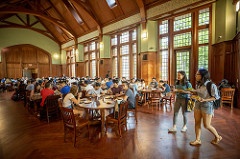The fields of infection biology, immunobiology and inflammation research is varied and ever-expanding. Researchers the world over are making discoveries that contribute greatly to our collective understanding of health and disease. VI4 is committed to providing our members, students, and community resources to aid in knowledge-building in these core VI4 research areas. Please check out our current curated recommended reading list below from scientists across the country.
Recommended Reading - March 18th, 2019
- Systematic discovery of antiphage defense systems in the microbial pangenome. Doron S, Sorek R, et al in Science, March 2, 2018
- Pulmonary neuroendocrine cells amplify allergic asthma responses. Sui P, Sun X, et al in Science, June 8, 2018
- Peptidoglycan synthesis drives an FtsZ-treadmilling-independent step of cytokinesis. Monteiro JM, Pinho MG, et al in Nature, February 22, 2018
- Immune cell census in murine atherosclerosis: cytometry by time of flight illuminates vascular myeloid cell diversity. Cole JE, Monaco C, et al in Cardiovascular Research, August 1, 2018
- A public antibody lineage that potently inhibits malaria infection through dual binding to the circumsporozoite protein. Tan J, Lanzavecchia, et al in Nature Medicine, March 19, 2018

Recommended Reading - February 22nd, 2019
- The Gut Microbiota Mediates the Anti-Seizure Effects of the Ketogenic Diet. Olson C, Hsiao EY, et al in Cell, June 14, 2018
-
Dimethyl fumarate targets GAPDH and aerobic glycolysis to modulate immunity. Kornberg MD, Snyder SH, et al in Science, April 27, 2018
-
Single-cell bioluminescence imaging of deep tissue in freely moving animals. Iwano S, Miyawaki A, et al in Science, February 23, 2018
-
Identification of Near-Pan-neutralizing Antibodies against HIV-1 by Deconvolution of Plasma Humoral Responses. Sajadi MM, DeVico AL, et al in Cell, June 14, 2018
-
Septal secretion of protein A in Staphylococcus aureus requires SecA and lipoteichoic acid synthesis. Yu W, Schneewind O, et al in eLIFE, May 14, 2018

Vanderbilt University
Photo: Anne Rayner; VU
Recommended Reading - January 25th, 2019
- Disruption of staphylococcal aggregation protects against lethal lung injury. Hook J, Bhattacharya J, et al in The Journal of Clinical Investigation, February 12, 2018
-
Heme ameliorates dextran sodium sulfate-induced colitis through providing intestinal macrophages with noninflammatory profiles. Kayama H, Takeda K, et al in PNAS, August 14, 2018
-
Precision editing of the gut microbiota ameliorates colitis. Zhu W, Winter SE, et al in Nature, January 11, 2018
-
Dietary Fiber Confers Protection against Flu by Shaping Ly6c− Patrolling Monocyte Hematopoiesis and CD8+ T Cell Metabolism. Trompette A, Marsland BJ, et al in Cell Immunity, May 15, 2018
-
Germinal center antibody mutation trajectories are determined by rapid self/foreign discrimination. Burnett D, Goodnow CC, et al in Science, April 13, 2018

Recommended Reading - January 7th, 2019
- Salt-responsive gut commensal modulates Th17 axis and disease. Wilck N, Müller DN, et al in Nature, November 15, 2017
- Gut microbiome influences efficacy of PD-1-based immunotherapy against epithelial tumors. Routy B, Zitvogel L, et al in Science, November 2, 2017
- Redox-Sensing Under Hypochlorite Stress and Infection Conditions by the Rrf2-Family Repressor HypR in Staphylococcus aureus. Van Loi V, Antelmann H, et al in Antioxidants & Redox Signaling, September 1, 2018
- Dietary and Microbial Oxazoles Induce Intestinal Inflammation by Modulating Aryl Hydrocarbon Receptor Responses. Iyer s, Blumberg RS, et al in Cell, May 17, 2018
- Single-Cell RNA-Seq Reveals the Transcriptional Landscape and Heterogeneity of Aortic Macrophages in Murine Atherosclerosis. Cochain C, Zernecke A, et al in Circulation Research, June 8, 2018

Recommended Reading - Sugar and Spice Edition
Our special guest-Curator for December's Recommended Reading is Maria Hadjifrangiskou, Ph.D., an Associate Director of VI4.
1. Antibiotic-induced changes in the microbiota disrupt redox dynamics in the gut. Reese AT, David LA, et al in eLife, June 19, 2018
2. Regulated Stochasticity in a Bacterial Signaling Network Permits Tolerance to a Rapid Environmental Change. Carey JN, Goulian M, et al in Cell, March 1, 2018
3. Bacteriophages are more virulent to bacteria with human cells than they are in bacterial culture; insights from HT-29 cells. Shan J, Clokie MRJ, et al in Nature, March 23, 2018
4. Candida albicans biofilm–induced vesicles confer drug resistance through matrix biogenesis. Zarnowski R, Andes DR, et al in PLOS Biology, October 8, 2018
This paper by Zarnowski et al., demonstrates that biofilm-specific extracellular vesicles (EV) produced by Candida albicans serve the community by facilitating the distribution of common goods such as extracellular matrix components.
Reduced EV production by interfering with the ESCRT machinery reduces exopolysaccharide abundance and induces drug hyper-sensitivity.
5. Modeling Cell-to-Cell Communication Networks Using Response-Time Distributions. Thurley K, Wu LF, Altschuler SJ in Cell, March 28, 2018
Modelling cellular conversations! From microbial cells to complex tissue micro-environments, one thing is common: signaling networks exist to facilitate cell-to-cell communication. Here is a scalable modeling framework that tackles cellular conversation using response-time distributions.

Recommended Reading - October 25th, 2018
-
Discovery and characterization of a prevalent human gut bacterial enzyme sufficient for the inactivation of a family of plant toxins. Koppel N, Balskus EP, et al in eLife, May 15, 2018
-
Staphylococcus aureus clumping factor A is a force-sensitive molecular switch that activates bacterial adhesion. Herman-Bausier P, Dufrêne EF, et al in Proceedings of the National Academy of Sciences, May 2018
-
Blocking Neuronal Signaling to Immune Cells Treats Streptococcal Invasive Infection. Pinho-Ribeiro FA, Chiu IM, et al in Cell, May 10, 2018
-
Atlas of the Immune Cell Repertoire in Mouse Atherosclerosis Defined by Single-Cell RNA-Sequencing and Mass Cytometry. Winkels H, Wolf D, et al in Circulation Research, June 8, 2018
-
Inflammation-induced IgA+ cells dismantle anti-liver cancer immunity. Shalapour S, Karin M, et al in Nature , November 16, 2017

Recommended Reading - September 27th, 2018
-
Identification of a Functionally Unique Family of Penicillin-Binding Proteins. Welsh MA; Taguchi A; et al. in Journal of American Chemical Society, November 28, 2017
-
Nociceptor sensory neurons suppress neutrophil and γδ T cell responses in bacterial lung infections and lethal pneumonia. Baral P; Umans BD; et al. in Nature Medicine, March 5, 2018
-
Extensive impact of non-antibiotic drugs on human gut bacteria. Maier L; Pruteanu M; et al. in Nature Medicine, March 19, 2018
-
Gut microbiome modulates response to anti–PD-1 immunotherapy in melanoma patients. Gopalakrishnan V; Spencer CN et al. in Science, Jannury 5, 2018
-
Functional interrogation and mining of natively paired human VH:VL antibody repertoires. Wang B; DeKosky BJ et al. in Nature Biotechnology, January 8, 2018

Recommended Reading - August 30th, 2018
- Host Nitric Oxide Disrupts Microbial Cell-to-Cell Communication to Inhibit Staphylococcal Virulence. Urbano R; Fang, FC; et al. in Cell Host Microbe, May 9, 2018
-
Dietary trehalose enhances virulence of epidemic Clostridium difficile. Collins, J; Britton, A; et al in Nature, January 18, 2018
-
Comprehensive skin microbiome analysis reveals the uniqueness of human skin and evidence for phylosymbiosis within the class Mammalia. Ross, AA; Neufeld, JD; et al. in PNAS, June 19, 2018
-
Gut microbiome–mediated bile acid metabolism regulates liver cancer via NKT cells. Ma, C; Gretan, TF; et al. in Science, May 25, 2018
-
In vivo imaging reveals a tumor-associated macrophage–mediated resistance pathway in anti–PD-1 therapy. Arlauckas, S; Pittet, MJ; et al. in Science Translational Medicine May 10, 2017
